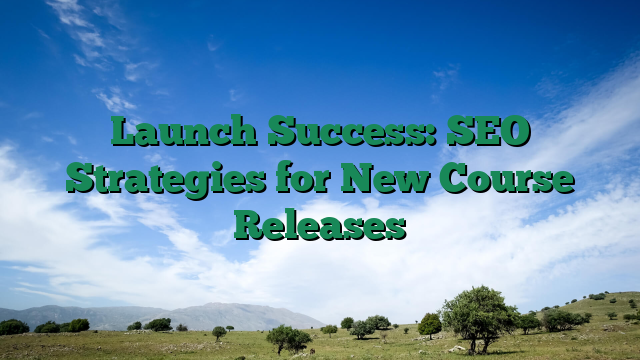Launch Success: SEO Strategies for New Course Releases
Launching a new course is exciting, but without the right course launch SEO strategies, your hard work might go unnoticed. Imagine spending months creating a high-value course, only to see it buried under a sea of competitors. That’s where product release marketing comes in. By leveraging SEO, you can ensure your course gets the visibility it deserves, driving traffic, engagement, and sales from day one.
In this guide, we’ll walk you through actionable SEO strategies for every stage of your course launch—pre-launch, launch, and post-launch. Plus, we’ll explore how you can monetize your content and turn your course into a profitable side hustle or even a full-time income stream. Let’s dive in!
1. Pre-Launch Keyword Targeting
Before you even announce your course, you need to lay the groundwork for SEO success. This starts with keyword targeting.
Why Keywords Matter
Keywords are the foundation of SEO. They help search engines understand what your course is about and connect it with the right audience. Without proper keyword research, you risk creating content that no one can find.
Step-by-Step Keyword Research
- Identify Your Niche: What problem does your course solve? Who is your target audience?
- Use Tools Like Google Keyword Planner or Ubersuggest: These tools help you find high-volume, low-competition keywords.
- Analyze Competitors: Look at the keywords your competitors are ranking for. Tools like SEMrush can help.
- Focus on Long-Tail Keywords: These are more specific and less competitive. For example, instead of “marketing course,” target “affiliate marketing course for beginners.”
Real-World Example
Let’s say you’re launching a course on “social media marketing for Small Businesses.” Your keyword research might reveal terms like:
– “social media marketing tips for small businesses”
– “affordable social media marketing course”
– “how to grow a small business on Instagram”
By targeting these keywords, you’re more likely to attract the right audience.
2. Launch Content Calendar
A well-planned content calendar ensures your course launch gets maximum exposure.
Why a Content Calendar is Essential
A content calendar helps you stay organized and consistent. It ensures you’re publishing the right content at the right time, keeping your audience engaged and informed.
How to Create a Launch Content Calendar
- Set a Launch Date: Choose a date and work backward.
- Plan Pre-Launch Content:
- Blog posts: “5 Reasons to Enroll in Our New Social Media Marketing Course”
- Social media teasers: Sneak peeks of course content
- Email campaigns: Build anticipation with countdowns and exclusive offers
- Create Launch-Day Content:
- Landing page: Optimize it with your target keywords
- Social media posts: Announce the launch with a strong CTA
- Webinar or live Q&A: Engage with your audience in real-time
- Post-Launch Content:
- Testimonials and case studies: Showcase success stories
- Follow-up emails: Encourage enrollments with limited-time discounts
Real-World Example
Imagine you’re launching a course on “Email Marketing Mastery.” Your content calendar might look like this:
– Week 1: Blog post on “Why Email Marketing is Essential for Small Businesses”
– Week 2: Social media teasers with tips from the course
– Week 3: Webinar on “How to Double Your Email Open Rates”
– Launch Day: Landing page, social media blitz, and email campaign
3. Post-Launch SEO Monitoring
Your work doesn’t end after the launch. Post-launch SEO monitoring ensures your course continues to perform well.
Why Monitor SEO Post-Launch?
SEO is an ongoing process. By monitoring your performance, you can identify what’s working and what needs improvement.
Key Metrics to Track
- Organic Traffic: Are people finding your course through search engines?
- Keyword Rankings: Are you ranking for your target keywords?
- Bounce Rate: Are visitors staying on your page or leaving immediately?
- Conversion Rate: How many visitors are enrolling in your course?
Tools for SEO Monitoring
- Google Analytics: Track traffic, bounce rate, and conversions.
- Google Search Console: Monitor keyword rankings and fix technical issues.
- Ahrefs or SEMrush: Analyze backlinks and competitor performance.
Real-World Example
After launching your course, you notice that your blog post on “Email Marketing Tips” is driving a lot of traffic but has a high bounce rate. You decide to:
– Add internal links to your course landing page.
– Include a strong CTA at the end of the post.
– Update the content with fresh tips and examples.
Conclusion: Turn Your Course Launch into a Profitable Venture
Launching a course is just the beginning. By implementing these course launch SEO strategies, you can maximize visibility, attract the right audience, and drive sales. But the potential doesn’t stop there.
Monetization Potential
- Affiliate Marketing: Partner with other course creators or tools and earn commissions.
- Upsells and Cross-Sells: Offer advanced courses or related products.
- Membership Sites: Create a subscription-based community for ongoing support.
Side Hustle Ideas
- Offer one-on-one coaching or consulting.
- Create downloadable resources like templates or eBooks.
- Host workshops or webinars for additional income.
How TheBizWizAcademy.com Can Help
At TheBizWizAcademy.com, we’re all about empowering entrepreneurs like you. Our online business blueprint includes courses on SEO, affiliate marketing, and more—all designed to help you turn your side hustle into a full-time income.
Ready to take your course launch to the next level? Join our community of 1000+ entrepreneurs and start your journey today.
By following these strategies, you’ll not only master product release marketing but also unlock the full potential of your course. Remember, SEO is a long-term game, but with consistent effort, the results will speak for themselves.
Let’s make your course launch a success—you’ve got this!
External Resources:
1.
2.
Note: This blog post is optimized for WordPress block formatting and adheres to TheBizWizAcademy.com brand guidelines.
🚀 Want to level up your online business? Join TheBizWizAcademy and start Networking and Learning!
